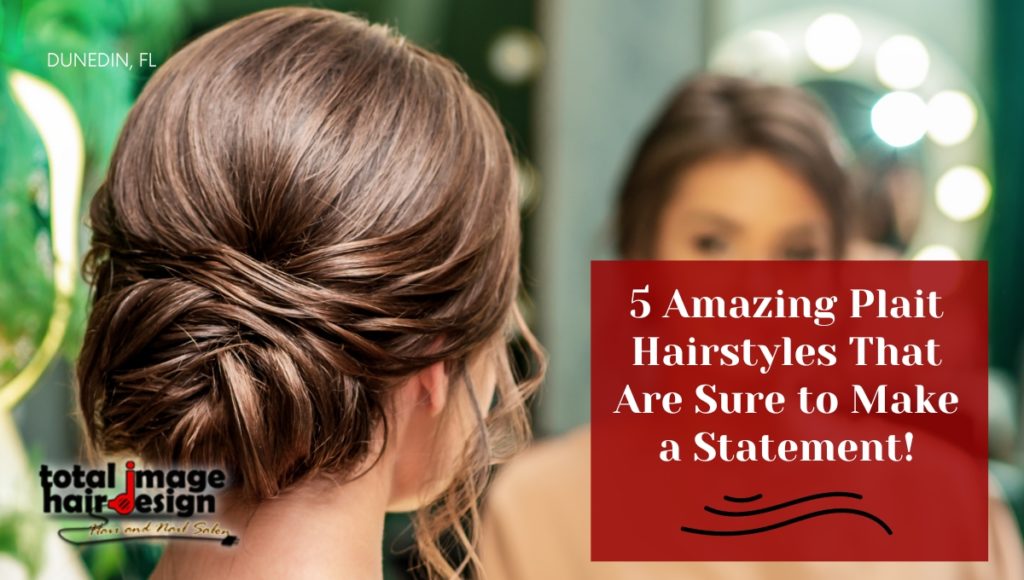3 Key Takeaways:
1. Plaits are a versatile way to style your hair and can be used to create statement hairstyles.
2. There are five different types of plaits discussed, including the three-strand, four-strand, French braid, Dutch braid, and fish tail braid.
3. Total Image Hair Designs in Dunedin, Florida offers a range of services to help transform your look.
5 Amazing Plait Hairstyles That Are Sure to Make a Statement!
 Plaits are a simple yet sophisticated way to style your hair. They are versatile, allowing you to create so many different looks and they can be dressed up or dressed down depending on the occasion. Plaits can also be used to create statement hairstyles that are sure to turn heads. In this article, we will explore five different plait hairstyles that are sure to make a statement. We’ll provide step-by-step instructions for creating each style and offer suggestions for variations.
Plaits are a simple yet sophisticated way to style your hair. They are versatile, allowing you to create so many different looks and they can be dressed up or dressed down depending on the occasion. Plaits can also be used to create statement hairstyles that are sure to turn heads. In this article, we will explore five different plait hairstyles that are sure to make a statement. We’ll provide step-by-step instructions for creating each style and offer suggestions for variations.
Three-Strand Plaits
The three-strand plait is the simplest of all the plaits. It is essentially a single rope-like strand of hair that consists of three sections that are looped over one another. To begin, part the hair into three sections and then hold one section in the left hand and the other two in the right hand. Cross the right section over the left, then cross the left section over the right and repeat. Once the plait is as tight as you want it, secure it with an elastic band.
Variations on the three-strand plait include adding colour, using accessories to cinch the ends, or pinning in the sides to create a stylish headband look.
Four-Strand Plaits
Four-strand plaits are a bit more complicated than three-strand plaits but still quite simple. To begin, create four sections in the hair, with two sections in the left and two in the right. Take the outside strand from each side (left and right) and bring it into the middle. To do this, cross the strand from the left side over the strand in the middle and cross the strand from the right side underneath the strand in the middle. Repeat this process, alternating over and under, until the plait is as tight as desired. Secure with an elastic band.
Variations on the four-strand plait include a fish-bone pattern, which is two three-strand plaits interwoven, or an infinity sign-like pattern.
French Braid
French braids are a variation of a three-strand plait in which the outside strands are pulled and added to the inner strands while braiding. To begin, separate the hair into three sections, with two sections in the right hand and one section in the left. Cross the left section over the middle section and then bring the outside right section underneath the middle section. Now, gather a small portion of the outside right section, pull it over and add it to the edge of the middle section. Cross the left section back over the middle section and then bring the outside left section under the middle section. Again, gather a small portion of the outside left section, pull it over and add it to the edge of the middle section. Repeat this process, alternating left and right sides until you reach the bottom of the head. Secure your braid with an elastic band.
Variations on the french braid include a Dutch braid (see section 4 below) or a reversed French braid.
Dutch Braid
A Dutch braid is essentially the same as a French braid with the only difference being that you cross the outside strands under the middle strand instead of over. To begin, separate the hair into three sections, with two sections in the right hand and one section in the left. Bring the right section under the middle section, and bring the left section over the middle section. Now, gather a small portion of the outside right section, pull it under and add it to the edge of the middle section. Bring the left section under the middle section and, again, gather a small portion of the outside left section and pull it over and add it to the edge of the middle section. Repeat this process, alternating left and right sides until you reach the bottom of the head. Secure your braid with an elastic band.
Variations on the Dutch braid include a fish-bone pattern, which is two three-strand plaits interwoven, or adding accessories such as ribbons or jewels to the braid.
Fish Tail Braid
Fish tail braids appear intricate and complicated but, in reality, they are not as difficult to create as they look. To begin, separate the hair into two sections, with one section in each hand. Take a small portion of hair from the outside right section, pull it over and add it to the left section. Then take a small portion of hair from the outside left section and pull it over and add it to the right section and repeat. Secure your braid with an elastic band.
Variations on the fish tail plait include side fishtail braids, which are created by starting the braid on one side of the head and working down to the other side, and adding accessories such as charms or beads to the braid.
Conclusion
In this article, we have explored five different types of plaits that are sure to make a statement. From the three-strand plait to the Dutch braid, there is something to suit any style and occasion. With a few simple steps and a few accessories, you can create an elegant and stylish look that is sure to draw attention.
For fine-tuned styling and modern looks, visit Total Image Hair Designs, a hair and nail salon in Dunedin, Florida, which offers a wide range of services. Stop in today and let their team of professionals transform your look!
Sources:
- Everyday Hair Inspiration. “3-Strand Braid.” 31 Aug. 2019, https://www.everydayhairinspiration.com/2019/08/31/3-strand-braid/.
- Brown, Kiera Aaron. “How to Create a French Braid in 7 Steps, According to a Pro Hairstylist.” Byrdie, 4 Jan. 2021, https://www.byrdie.com/creating-a-french-braid-5070504.
- Barnes, Madison Alcedo. “How to Do a Fishtail Braid in 5 Easy Steps.” Good Housekeeping, 17 July 2020, https://www.goodhousekeeping.com/beauty/hair/how-to/g2987/fishtail-braid-tutorial/.
- Luxy Hair. “How to Do a Dutch Braid: Hair Tutorial for Beginners.” https://www.luxyhair.com/blogs/hair-blog/how-to-do-a-dutch-braid-hair-tutorial-for-beginners.





